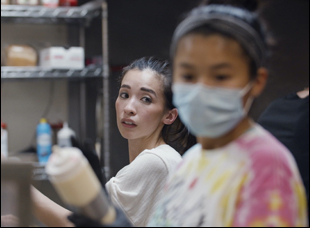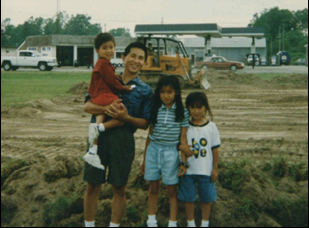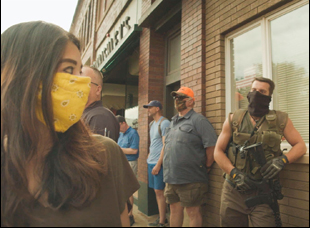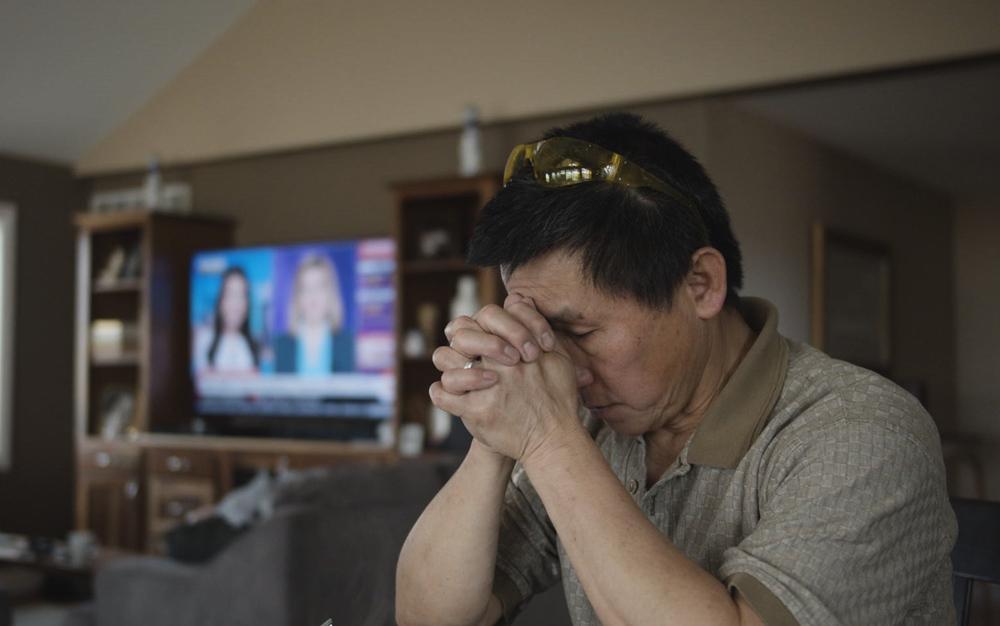“David, why are you filming me right now?” his sister Jaclyn Siev asks in “Bad Axe” as she’s perusing photos from the week before when her family enjoyed a cruise. Somehow it feels as if she’s even further at sea when back on land in her Michigan hometown, spending time with her parents Chun and Rachel and David that she couldn’t have predicted when she left Ann Arbor in March of 2020. Accustomed to driving into Bad Axe on weekends to help out at Rachel’s Food and Spirits, the restaurant which helped afford an education that could land her a corporate job in the city, she felt no choice but to work there full-time as business slowed to a trickle at the start of the pandemic and beyond a pivot to takeout, she felt it was incumbent upon her to look after everyone’s well-being except perhaps her own.
It’s pretty evident from the start why David, a one-time assistant to “Jackass” mastermind Jeff Tremaine, would want to keep the camera rolling, particularly on Jaclyn, a pillar of strength in uncertain times, but he tells his sister it’s because he has nothing better to do when she first asks and gives another answer to his father, saying “It’s an important time in history,” and it’s likely he was the last to entirely know his motivation. Like his sister, he couldn’t possibly imagined what would unfold as his family struggled to make ends meet when they couldn’t open their doors and endured racism that his father Chun had surely thought he had put behind him after leaving Cambodia and becoming a fixture of the Midwestern community, first with a donut shop and then with the cafe named after his wife, and as “Bad Axe” illuminates in vivid detail, the external pressures brought about by COVID start to create unmanageable stress inside the Siev household, with the unflinching camera capturing it all.
The result is one of the most definitive portraits of living through the pandemic in America where preexisting tensions of race and class were laid bare and issues that the long-assimilated felt were in the past-tense reared their ugly head in the present as a virus that had no cure spread along with the hateful rhetoric that Asians were responsible. Siev is able to chronicle a reckoning as their business is bombarded with hateful messages from people they knew as regular customers and neighbors and the parents that once were able to see a bright future for their kids found it hard to see one for themselves, so enmeshed in providing their kids with the opportunities that they didn’t have that when David, Jaclyn and their other daughter Raquel see the world as it is, they appear to prefer to see it the way it was when they could just bond with the community over Wolverines football and the inclement weather. Following a premiere at SXSW earlier this year where it became the talk of the festival, “Bad Axe” is now making its way into theaters and we caught up with the family when they made it out to the west coast for the L.A. Asian Pacific Film Festival who spoke about dealing with the unexpected during the pandemic, including having their every movement being filmed, and how Siev balanced out the responsibilities of being a son and a filmmaker, knowing that his family would be characters in a story but cared for as his own flesh and blood.

Rachel Siev: I think he’s always had a camera at some point, doing something or capturing our memories…
David Siev: Yeah, I think part of the reason the film feels so raw and intimate as it does is because my family got used to the camera very, very quickly. When they’re talking with me, they’re not really talking to a camera – [they’re talking] to the brother, the son, and they were already used to my being a filmmaker. Going back to how this started, when my girlfriend and now fiancee and I moved back to Bad Axe, Michigan from New York during the pandemic, I had just lost my job like so many other people in the film industry did. Part of me always knew that I wanted to share my family’s story, specifically with my dad being a Cambodian refugee and my mom being a Mexican-American, two hardworking, passionate individuals who don’t have an education beyond a high school diploma. They were able to lay this foundation for this American dream that we all built together, and when the pandemic started, I just began capturing their stories, really the history of how they met and when they opened the first donut shop – all these questions that I had.
Then the other part of me was just filming life every day as it was, really for myself, not really knowing it would become part of the documentary. We were all young adults now living under our parents’ roof again during a very crazy and uncertain time and I wanted to have these memories because I didn’t know when would be the next time we’d all be under one roof again. Then as you see in the film, these parallels began to form of this story of the American Dream I’ve recaptured with my parents telling me how the restaurant came to be what it is and then also what it took to keep that American dream alive during a very uncertain time. Once I began to see that parallel, that’s really how the film began to take the shape that it is now.
Jaclyn Siev: And when you asked that question, we [would all say] in the more vulnerable moments, “David, turn that friggin’ camera off” because you’re crying or you’re fighting… those parts were a little bit harder to…

Jaclyn Siev: I’m not going to lie, there was a point on that first sushi night [at the restaurant], [where] we were so in over our heads because we had never done takeout before, we were like, “Where is David? And someone said, “He’s recording” and it’s like, “Tell him to put that camera down and get back here and spread rice right now.” That was one of the times where David was like, “Okay, I guess I’m putting the camera down.”
David Siev: That’s where I got those time lapse shots. [laughs] I [thought] I can’t really be shooting now, so I’ll set the camera in the parking lot.
Chun Siev: I have to say that as the Asian-American dad, we have a really thick skin. I’m speaking for myself when we come to this country. We lived through a lot with what people said about us and we also have a lot of pride, and we don’t share our family drama with anybody, so it’s really difficult when David started to pick up the film, right in the middle of the toughest time when the fear of the illness and the fear of the safety of the children. And we would get in an argument and he’s got the camera right in your face and you’re like, “Dude, put the fucking camera down.” [laughs] Because you know what? This is not for anyone to know about.
But [now I] know what this camera that he used has become [with] the movie today that inspires so many young adults. [People say] “Your children have a lot of courage to speak out for what they’re speaking out [about]. And it took a lot. Was I scared at the time? The answer is yes.
Jaclyn, when you know there’s going to be a movie at the end of this, was there anything that was important to you that comes across?
Jaclyn Siev: The most important thing to me was that when the trailer was released [for the crowdsourcing effort], I think it might’ve been some of the things that I said that maybe generated some of the backlash and the uncertainty from our community around the film. Maybe they thought I was bashing Bad Axe or saying bad things about my hometown when that was never my intention. My intention was just to speak through the true experiences that I had experienced, the good and the bad. And now that it’s come out, hopefully people now see I love Bad Axe. I chose to move back very recently to start my little family there. And that doesn’t mean that I don’t have frustrations or things that I wish I could change. I might have some different views than other people, but at the same time, I love Bad Axe just like I love my family.
I don’t have the same views and opinions as my dad clearly as you see. [laughs] Though we’re different, we’re still a strong family and we still love each other. I don’t think there’s a question as to whether or not I love my family and I hope there’s not a question as to whether or not I love Bad Axe because I do. We are different at the end of the day, but that doesn’t mean we can’t come out stronger together and that doesn’t mean we don’t love each other, so I hope that comes out in the film. And I stand by the things I said when it comes to neo-Nazis. [laughs] But everything else, I hope that [audiences] can see everything else was out of love in one way or another.

David Siev: That was definitely something to work towards. The process of getting a rough cut was really interesting. I never made a documentary film and I didn’t know how you were supposed to start. We had like 50 days of footage and I told our first editor Peter Wagner, “do me a favor and just put this together as an assembly. You can put music under it, you can do what you need to do, but just put it in order.” Then I had a 10-hour timeline of the best [material from] this 50 days of footage, and I reverse engineered a script based on that. I actually wrote scene and character descriptions because that’s what I knew when I came to writing that narrative form of storytelling, so basically I had this 30-page script and I gave it to my editor and he said, “Great, start taking out this footage and start putting it together as it is in this script.” As far as introducing every character and showing every perspective, the scriptwriting helped a little bit with that, but you learn that documentary filmmaking is a completely different process than narrative filmmaking, so finding the right moments of how and when to introduce the characters took hours in the editing room, figuring out including myself in the film. I never intended to be in the film at all, but I really do thank my fiancee for that.
That [decision] actually happened at the moment it does in the film and it was because she said, “We need to sit down and get you…” and I’m like, “I don’t want to be in the film. I don’t think I need to be in the film.” And as we were doing early cuts, a big question was why is this story being told? The answer to that was the love for my family. Once it became clear that I had to be in the film in some way, that ended up giving the film so much more motivation as to why this story was even being told. But it took months and months of finding the right way to weave in every character and showing everyone as ugly and beautiful as human beings are. [laughs]
I was always tried to be as respectful as I could of my family, especially in the editing room. You want to be truthful as a filmmaker as much as you can and at the same time, you want to be respectful as a family member to make sure if you are showing something that’s vulnerable and personal, it has intention. Balancing that line was tough to do. Luckily, we did it together as a family. They saw the earliest cut when we were a year in and I think you can see that tension of putting the film out there in one of the scenes [about the crowdsourcing campaign]. We debate, “Do we put it out there, do we not?” It was a genuine conversation that we had and it was never a question of do we keep filming or not because I was always going to keep filming and that’s not what bothered them. It was always how you were going to use this footage to piece together a film, so being respectful and hearing everyone’s opinions, I’d like to think I was able to achieve that as far as telling the truth of it all while also being respectful of whose truth I was telling.

Chun Siev: As an Asian-American, we’ve been through a lot and I’m glad I was part of the history that lived through today. I’m so happy and so proud of the indomitable spirit that the Asian-American has and that the younger generation like my children are able to speak out for who those still shy away from [talking about their experience].
Rachel Siev: It’s been wonderful. I think it’s opened up a lot of conversations, which I’m really happy to have happened. People [are] coming up to us and relating to all of us in one way or another where “Oh, I have a Jaclyn in my family” or “My dad is like that,” but also the other tougher points of that conversation. That’s been a positive, so even though it might not be easy to talk about, it’s been a good experience. What I like out of it is the conversation.
“Bad Axe” opens on November 18th theatrically in New York at the IFC Center and in Los Angeles at the Laemmle Glendale and available on demand.




